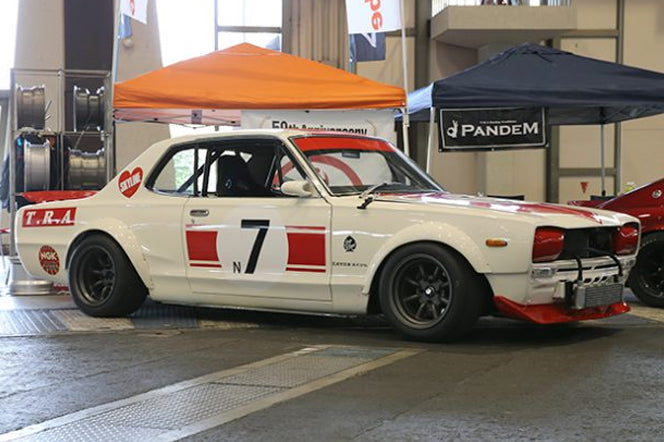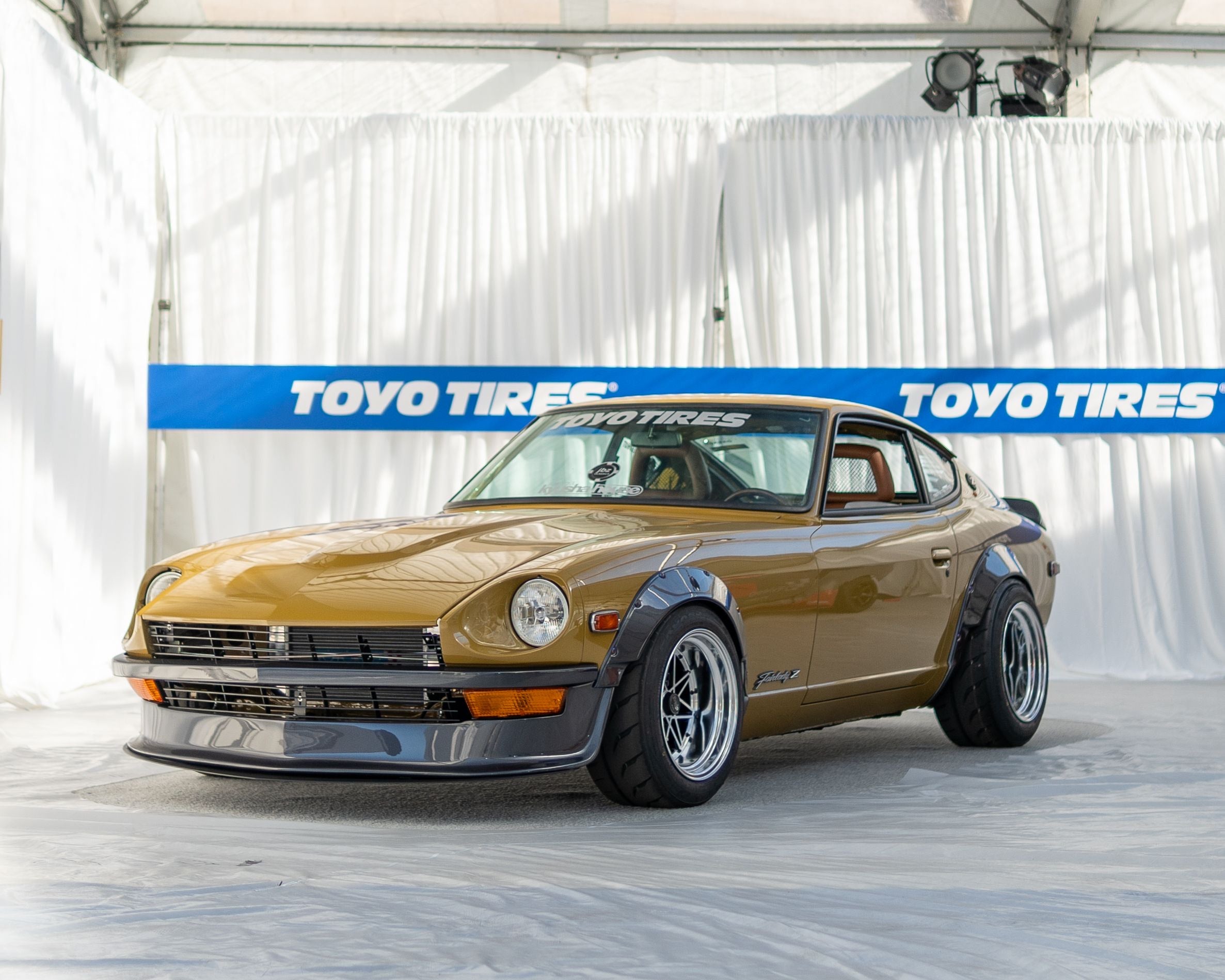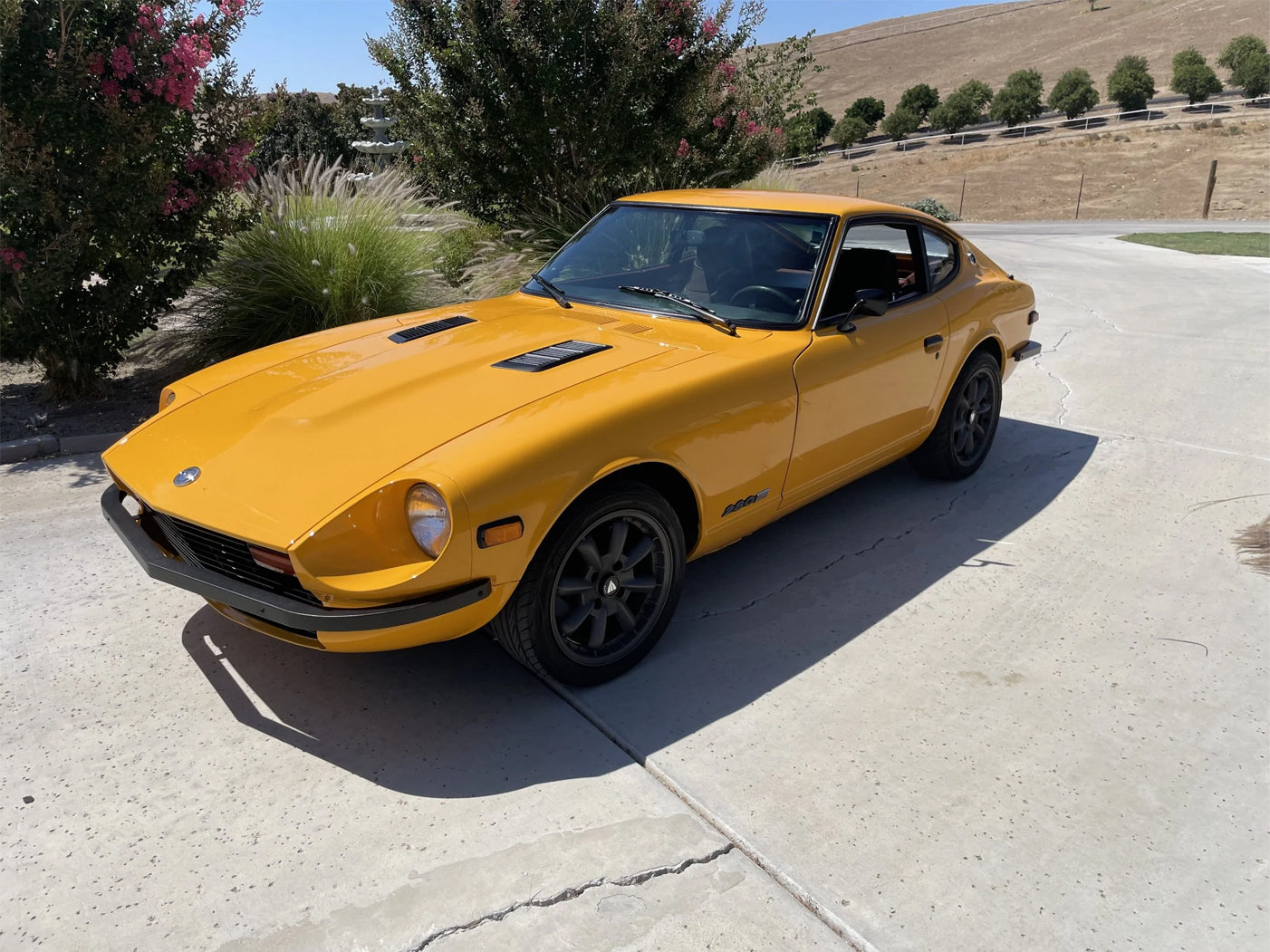There is some cool history between Watanabe wheels and Datsun cars, and they both resulted in some serious changes in the worldwide car industry.
Watanabe wheels, which are sometimes called "Wats" by its fans, are strong and light racing wheels. When Nissan saw these new wheels and Watanabe's participation in the Japanese racing scene, they adopted these wheels in their factory racing department and, over the next few years, won a staggering 49 consecutive racing wins! This brought a lot of attention to both companies and proved their capabilities on the race track.
The industry cars had a major shake-up because of Watanabe's eight-spoke wheel design. These wheels look great; they have improved strength and race mechanics, they are more stable and faster, and they have much more love and dedication poured into the design.
The design was way ahead of its time, so much so that it made a lasting impact on today's cars. If you look at race car wheels today, you'll see similar styling, and virtually all racing wheels are aluminum now. It also helped Datsun cars finally break into the spotlight.
Watanabe's story is filled with creativity, beauty, and never-giving-up, all of which serve as an inspiration for car fans and modern manufacturers.
Let's dig into this!
Disclaimer: This article is authored by a member of the Skillard community and reflects their personal views, not necessarily those of Skillard. We welcome your feedback and corrections in the comments to help us continually improve this content.
Table of Contents
History and Heritage of Watanabe Wheels
When Watanabe wheels burst onto the racing wheel business scene, racing wheels were getting a lot of attention, but back in those days, most wheels were heavy steel, which really slowed down cars.
In 1962, Toshiyuki Watanabe launched his business, Racing Service Watanabe Co., Ltd. Toshiyuki was an innovative guy; with the rising popularity of Japanese cars came a major game-changer for the company; he shifted his focus, paying closer attention to speed factors that were often overlooked. He introduced a new idea that said speed has many uses beyond a loud engine—wheel choice matters a lot, too. He would frequently race his Fairlady 2000 and his 240Z.

When Watanabe Wheels introduced these new wheels to the Japanese market, not only did they grab the industry's attention, but they also really upped the game for Japan's automobile standards. They zeroed in on two main goals: creating visually stunning wheels that also performed exceptionally well. Their obsession with different tech, like using aluminum instead of traditional steel wheels, showed their dedication to boosting speed, not just to make a profit.
Because of this determination, the outcome was wheels that both pleased the eye and also improved any car they were attached to. Particularly, the RS Watanabe, with its distinctive design and performance features, has become a sought-after choice among car enthusiasts.

The remarkably simple 8-spoke design from Watanabe surpassed just about every other wheel and was way ahead of its time, something that often leaves BBS fans grumbling quietly. What they did was develop their design, experiment with and improve it many times (all thanks to the contribution of many people), and finally produce a truly top-notch racing wheel.
Check out how popular these wheels are among fans who love classic cars like the Fairlady, Bluebird, and GT-R. Cars like the Datsun 240Z, 260Z, 280Z, and 510 have all earned their reputation as stylish speedsters while sporting these wheels. From Hondas to Nissans and Mazdas to Toyotas, many race fans adore Watanabe wheels; even enthusiasts of German cars like Porsche and BMW can't help but love them!
Watanabe wheels have undoubtedly secured a firm place in the scene of classic JDM cars or Kyusha. Their combination of lightweight durability often plays an important role in racing. Designs like the R-Type and F-Type have risen to fame in the fast-paced world of motor racing, enhancing the brand's appeal on the track.

Fast forward to the present, Watanabe wheels are still crafting great new products in the heart of Yokohama City; yes, I'm talking about their F8-type Watanabe wheels released a few years ago, and for the new Nissan Z just a few months ago! They've successfully carved out a solid place in the aftermarket arena.
How Does Watanabe Compare to Other Wheels?
Watanabe is well-known for offering plenty of car customization and performance tuning choices. With their special mix of style and function, they are a great choice for many. If you put them up against other popular brands like Panasport, Volk, and Rota, some differences start to pop up.
Car owners who love the old-school and vintage vibe may opt for Panasport wheels. They also tend to gravitate towards Watanabe. Still, there's a small difference: Panasport seems to pull a slightly different crowd with its unique design style. Plus, they're big on 8-spoke rims, often showing up in the same convos as Watanabe, so it might be worth digging into. You may have even heard of Panasport's famous Watanabe lookalike, which 240Z owners seem to like a lot.

Volk Wheels is a standout brand in Ray's Engineering Group and has earned itself a respected place in the car industry. This brand draws much attention from racing enthusiasts thanks to its durable and lightweight wheel designs, often created from high-quality materials like magnesium. Volk's approach to combining fresh style trends with reliable performance hits the mark big time. By breathing new life into a familiar product with novel, powerful ideas, they prove their influential role in the market. If you're after innovative changes in wheel design, you should check them out!

Next up, we have Rota wheels. With a range of styles and a friendlier price tag, they attract a wide customer base, but they don't often manage to nab the legendary status or racing history of Watanabe wheels.

Then there's the Diamond Racing SC Series. They're stylish and not too heavy on the wallet, but the weight of the wheels themselves might not impress everyone. They opt for steel, while Watanabe pushes for lighter aluminum racing wheels. Not everyone's cup of tea, but some car lovers swear by them.

One thing that sets Watanabe wheels apart is their aerodynamic design - their "aero" style really makes an impact on sport car buffs looking to amp up their car's performance, whether they're driving a sleek coupe or a high-powered turbocharged ride.
Even smaller items like center caps and wheel accessories count, too, helping to shape the general look of the vehicle. Watanabe's dedication to these fine details is part of what makes their wheels so engaging.
But looks aren't everything. Watanabe wheels also pack a punch in the tech department. Their innovative take on lessening unsprung weight with lightweight materials really ups the ante on performance. This is similar to how improvements in struts and suspension systems can boost how a vehicle behaves.
Technical Advancements and Performance
Let's dig into simple ideas that may sound technical: sprung weight and unsprung weight.
- Sprung weight describes the parts of your car that are supported by the suspension system; I'm talking about the body, engine, and chassis.
- On the flip side, unsprung weight is comprised of components like wheels, tires, and brakes that your struts, coilovers, and the rest of your suspension system don't cushion.
So, why does this matter for racing? Well, here's the deal. When you lower the un-sprung weight, you get less disruption from bumps on the road, which increases car stability. In simpler terms, a lighter unsprung weight heightens the wheel's contact with the road, which means better traction and control over the car.

Next, let's talk about wheel weight. On any given race day, you'll find a bunch of drivers choosing lightweight wheels. These aren't just fancy, expensive additions; they drastically improve the car's performance.
Lightweight wheels need less energy to spin and stop. This means faster starts and stops. Plus, they also lessen the car's total weight, knocking off some precious seconds from your lap times.
Before the 1960s, Japanese racers were aware of Minilites, popular lightweight alloy race wheels from the UK. But here's the issue: getting these wheels to Japan was very expensive. Watanabe spotted a golden opportunity and came out with their own ultra-light rims.
These forward-thinking rims presented a less expensive and easier-to-obtain option, which really improved car control, speed, and weight. When Watanabe rolled out these rims, it was a major turning point. It offered a solid solution to the widespread use of weighty steel wheels; at the same time, it waved goodbye to the budget and operational headaches related to importing Minilites into Japan.

Watanabe's innovative wheels weren't just a game changer for Nissan or a specific brand of vehicles. Their invention really pushed the boundaries in car racing. By reducing unsprung weight, Watanabe helped racers push their cars to even more thrilling limits. They may not have single-handedly transformed the sport, but they definitely made a big impact!
Fitment Guide for Watanabe Wheels and Datsun Cars
When it comes to Watanabe wheels and Datsun cars, there are two main types of fitment styles to consider: the original, or stock, and the altered or modified. Both play a big role in how the car looks and works.
The stock fitment means that the wheel sizes and specifics match what the Datsun originally came with, keeping everything, including the suspension, brake size, and bodywork, just as it was when it left the factory.
Take the Datsun 240Z, for instance. This baby usually fits nicely with 15x6.5-inch Watanabe wheels that have around 3.75 inches of backspacing. This type of wheel tucks perfectly into standard wheel wells and works great with the original brake and suspension set-up. It's important (and I mean really important) that the chosen wheel diameter, width, and backspacing all match up with the Datsun model's original specs. Otherwise, you might run into issues like the tires scraping against the fenders or the wheel being misaligned. It's not fun, especially considering how much those rims cost.

The modified fitment happens when you decide to make changes, like upgrading the suspension, tweaking the brakes, adding fender flares, or rolling the fenders. Adding these modifications allows for a greater variety of wheel sizes and offsets. But these changes need a careful look-over to avoid any compatibility problems. You can't just find your sizes off an article like this one; you'll have to take a lot more time to measure, check, and double-check before ordering your new wheels.
In this case, let's say a Datsun 510 gets some added fender flares; now it can fit larger wheels. You could even go so far as to consider wheels as hefty as 18x10 inches with a 4.5-inch backspace, as long as the suspension is adjusted for the right amount of clearance. Changes in the suspension, think lowering or adding coilovers, can have a huge impact on wheel fitment.
You might be able to fit bigger wheels, but really, this entails subtle tweaks in camber and toe settings for even tire wear. If you decide to scale up the brake calipers and discs, you'll also need to increase the wheel diameter or tweak the offsets for correct clearance.
Whether you have a stock or modified car, it's important to match the wheel's bolt pattern with your Datsun's specs. Classic models usually need a 4x114.3 pattern. The center bore size of the wheel must fit perfectly onto your Datsun's hub to prevent any vibrations and ensure the wheel is centered. It's also necessary to think about the outcome of wheel size and weight on how the car handles since heavier or larger wheels can change how the car speeds up, how it brakes, and how the suspension performs.

Before grabbing a new pair of wheels, it's always a good idea to chat with a wheel fitment specialist or a mechanic who can help you find the best wheel size, offset, and tire combination that's going to work with your modified set-up.
It's better to measure three times and order once, right?
What do you think of Watanabe wheels, and which size did you end up buying for your Datsun? Let's get a conversation started on this; drop us a message in the comments box. We'd love to hear from you!






2 comments
Skillard Team
Hey James, glad you found the info useful!
To fit tires/rims on your Z without rubbing, you have to measure inside and outside wheel space, then calculate the backspacing. Check tire-to-fender gap with a string and weight, and adjust for fender edge thickness. Always subtract at least 2mm for safety.
Here is a helpful video that shows some of these things, like the formula and using a caliper to measure: https://www.youtube.com/watch?v=6hgfjuE2tnE
Hey James, glad you found the info useful!
To fit tires/rims on your Z without rubbing, you have to measure inside and outside wheel space, then calculate the backspacing. Check tire-to-fender gap with a string and weight, and adjust for fender edge thickness. Always subtract at least 2mm for safety.
Here is a helpful video that shows some of these things, like the formula and using a caliper to measure: https://www.youtube.com/watch?v=6hgfjuE2tnE
James
Very nice collection of information on the S30 wheels. Thank you for putting this together. One of my Z’s is lowered, with a Suspension kit, and brake upgrades. Is there a step-by-step way of measuring the car/wheel space to make sure you optimize the size of the tire/rim but not have rubbing issues?
Very nice collection of information on the S30 wheels. Thank you for putting this together. One of my Z’s is lowered, with a Suspension kit, and brake upgrades. Is there a step-by-step way of measuring the car/wheel space to make sure you optimize the size of the tire/rim but not have rubbing issues?